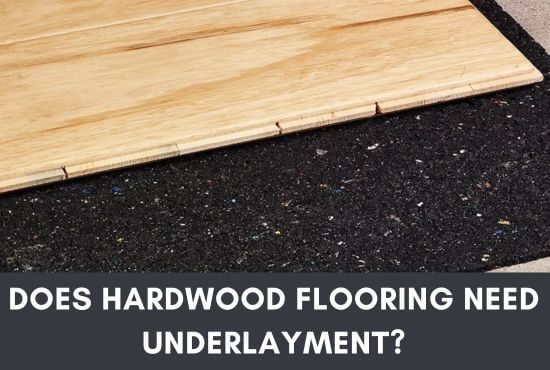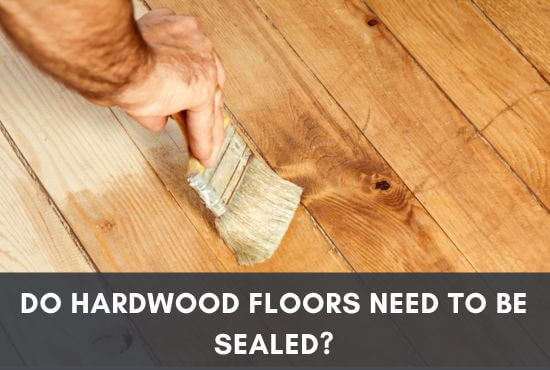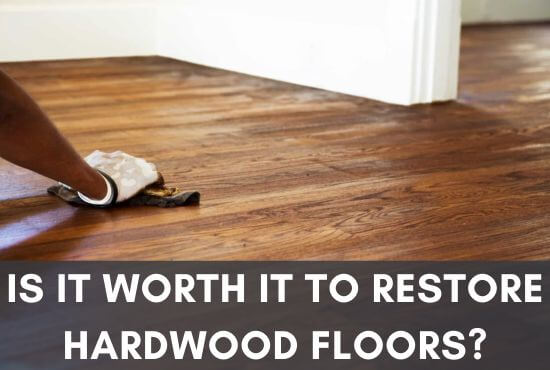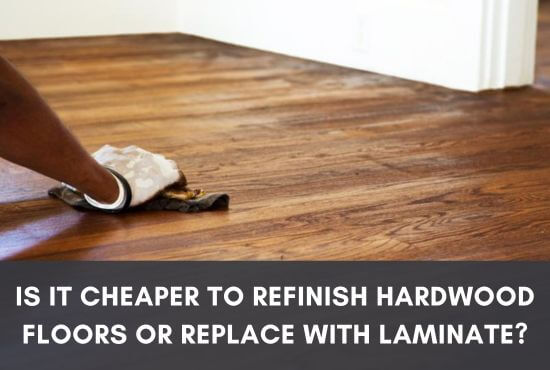Hardwood floors are one of the most interesting features in the interior of a house. They are a value addition to your property and a source to make your floors look as luxurious as they can be.
While many people love the look they provide to your house, a lot of people are against them as they are supposedly a colder surface in both winter and summer.
However, many people tend to disagree while others list out ways to make this problem go away. So the question here is, Do hardwood floors make your house colder?
Hardwood floors can make your house colder due to wood’s natural coldness as a good conductor and poor insulator. This characteristic enables wood to easily absorb and disperse heat, leading to a reduced perception of warmth within the living space.

However, this also translates to the fact that it can’t retain heat and will hence, make your house colder.
While this is a desirable option in hot summers, it might not be the best choice for some people for winter. But provided their elegance and class, one would surely want to overlook this feature.
Worry not as we have listed many ways in which you can keep your hardwood floors warm during winter. And if you live in a hotter climate, you will find these floors extremely suitable and helpful to keep the temperatures from rising too much.
Read along to find out more about cold hardwood floors and how to deal with them in an efficient manner.
Table of Contents
Do Hardwood Floors Make Your House Colder?
Hardwood floors make the house colder due to wood’s natural coldness as a good conductor and poor insulator if you don’t have any means of insulation for heating the house.
As wood is naturally cold and a better conductor than an insulator, it disperses off the heat and prevents it from staying on the surface.
However, longer exposure to adopting insulation methods such as sealing, placing carpets, and others mentioned below can help retain the heat in hardwood floors.
Many other factors might be involved in the coldness of your house, apart from hardwood floors.
While they are an exquisite investment and offer a beautiful look in your house, you might face some problems living in a colder environment.
Hardwood can get cold in winter, which can make the overall temperatures of your house go down significantly, depending on how much of the area is covered by hardwood flooring.
Though they are an excellent way to keep the house cool in summer, winter can be a bit harsh, and you will have to take steps to make the house and the floors warmer.
7 Ways To Keep Hardwood Floors Warm
If you are also concerned about hardwood floors getting cold under your feet and causing problems walking barefoot, we’ve got you covered.
Although hardwood floors are not the only factor responsible for coldness in your house, they can surely give you cold tingles when you walk on them without shoes and socks.
If you want to avoid this and prefer a soft and cozy touch to your feet, follow the methods mentioned below, and this problem will be solved once and for all.
1. Get An Area Rug Or Carpet
For those who don’t want any headache of getting their floors checked or having additional measures to keep the floors warm.
Although hardwood floors are an adornment and do not require an accessory or add-ons to make them appear more aesthetic, using rugs and carpets will allow the floors to retain heat and warm the wood.
As wood is a conductor and rugs/carpets are insulators, they can trap the heat on the surface and allow the floors to absorb it over time.
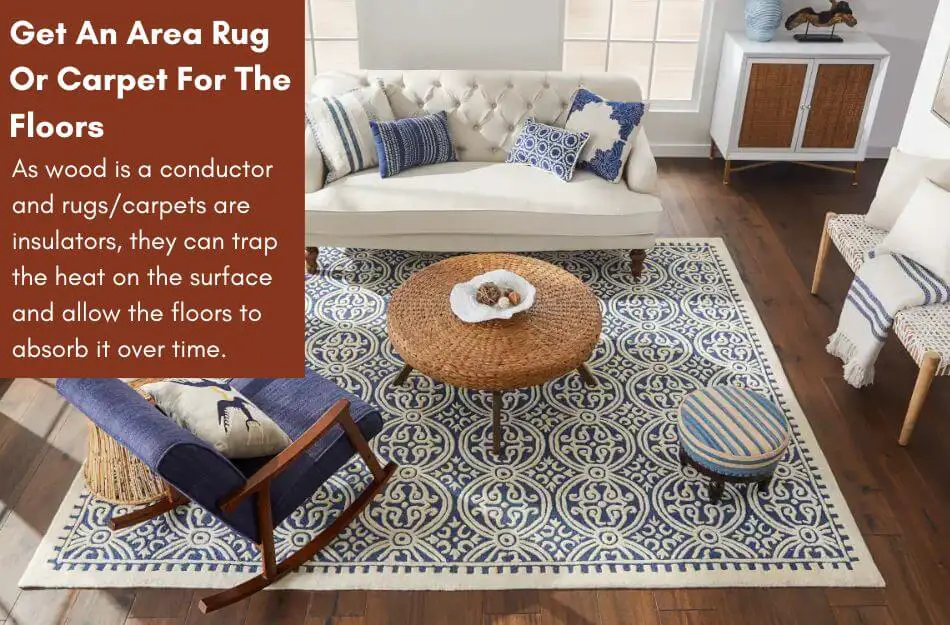
This long-term solution can keep your floors warm throughout the area. If you live in a colder climate, carpets will be your greatest savior.
You can save money on gas and electricity as heaters won’t be necessary if time.
The carpets and area rugs are warm and do not let the floors get cold. Hence the house’s temperatures remain moderate, which is impossible with hardwood floors.
Pro Tip: Regular cleaning of area rugs on hardwood floors can make them last longer and shinier.
They allow you to walk barefoot without worrying about cold floors or getting your feet dirty. The soft and cozy feeling under your foot is unmatched and can’t be experienced without hardwood floors.
It is suitable to select thick and fluffy carpets and rugs for the best floor heat retention. In addition, while you’re at it, it is best to choose the right color palettes and designs which will add to the aestheticism and overall appeal of your home. as per the color palette of your house.
Refrain from choosing bland designs and trite colors; it is useful to consider this an opportunity to further decorate the interior of your house without having to change flooring or do much expenditure.
You can choose high-traffic areas and the most frequently used rooms to install the area rugs and carpets.
This way, you can get the heat in your desired areas without bearing the expense of covering the entire flooring.
This method will allow you to exhibit your expensive hardwood floors, as you don’t want them hidden underneath the rugs and carpets.
On the other hand, it is sometimes quite difficult to clean the floors when the carpets or rugs are installed.
But no worries, I have also written a detailed guide on cleaning the hardwood floors after removing carpet which I highly encourage you to read before you destroy your precious floors with bleaches or other chemicals.
2. Monitor Hardwood Floors Condition
While many people tend to ignore this, the condition of your hardwood floors can be a major deterrent for them to get warm.
Often, floors that are worn out do not have ample insulating strength, which makes it impossible for them to retain or absorb any heat. This can lead to colder floors and cause problems while walking barefoot.
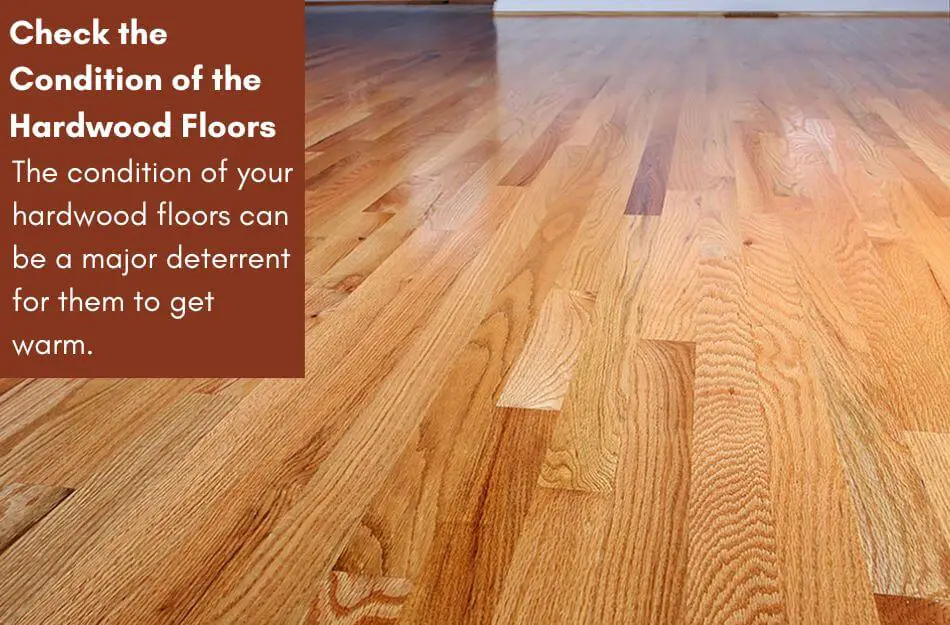
Therefore, it is suitable that you thoroughly check the floors and look for dents, scratches, scuff marks, and other signs such as crowning, buckling, and more.
If any of these are found on your floors, it is likely time that you book a refinishing or a resurfacing session with a professional. However, you can also do it yourself by following my DIY guides:
Once your floors have been treated and repaired from the damage, you might see better results in this context.
In addition, the condition of your varnish is also an important factor in this situation. The varnishes can also insulate the floors and trap heat so the floors can get warm.
However, if the finish is worn out and needs more thickness or strength, it might fail to retain any heat resulting in colder floors.
3. Get A Space Heater
Hardwood floors can’t absorb heat if there isn’t any heat source on the floors. It is appropriate to get a space heater for your living room or dining hall which can emit heat so the overall temperature of the house remains moderate and the floors are kept warm.
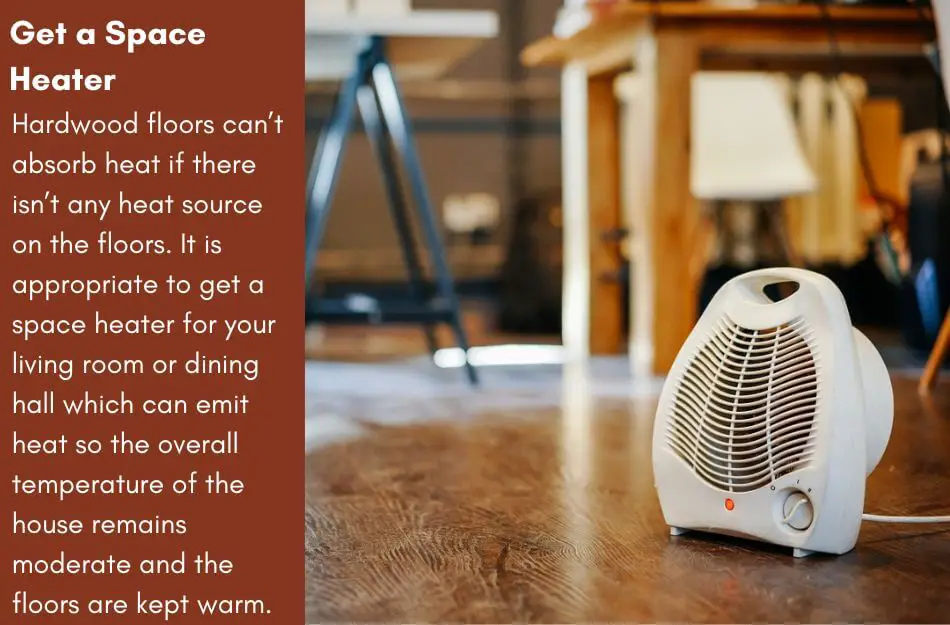
Besides, space heaters are portable, and you can place them anywhere in the house (wherever there is a gas hose or a socket, depending on if the heater is electric or not) and turn it on for an hour or two to make the area cozy enough for you.
Moreover, they are the most energy-efficient, so you don’t have to worry about hefty bills at the end of the month. Hence, you can enjoy a moderate temperature in cold temperatures affordably.
4. Seal Cracks
Cracks in hardwood floors are sometimes the worst cases which can cause extremely cold floors. The cracks can cause the heat to escape into the subflooring structure or the surface underneath, leaving the floors colder than ever.

Hence, a suitable solution is to get them treated and seal the cracks to ensure that the heat caught by your hardwood floors is not lost to the surface beneath or the subflooring structure.
Furthermore, having windows or doors open can also prevent the wooden floors from getting warm, as the increased airflow would result in lower temperatures and the heat will be lost in the wind.
Therefore, make sure that the windows and main doors are closed so the floors can absorb some heat and get warm enough for you to walk on them.
5. Check The Ventilation System
Hardwood floors indeed give a cold sensation to those walking on them barefoot. However, if the floors are too cold and do not get warm despite any actions, it is recommended that you get your ventilation systems checked.

In many cases, the dysfunctionality of the furnace can result in poor insulation, which keeps the overall temperatures of your house very low.
The heat produced would not be enough to keep the floors warm and the house’s temperature moderate.
Some professionals even say checking the ventilation system should be your prime priority if you face the problems of strangely cold floors or consistently dropping temperatures in the house.
6. Get An Underlayment
Many problems mentioned above can be countered if you get an underlayment for your hardwood floors. Hardwood floors are often criticized for not being suitable for colder environments as they are very cold and do not retain heat very efficiently.
This makes the overall temperatures in the house much lower and makes it almost impossible to walk barefoot on the floors.

Moreover, having hardwood floors in winter means you must be ready for a cold floor in your house. While many homeowners sought the support of carpets and rugs in this situation, an underlayment installation can be your permanent solution to this problem.
As hardwood floors are referred to as being chilly in winter, underlayment can solve this problem once and for all.
It allows the floors to retain the heat generated from the heaters, movement, and bodily heat, which is transferred upon contact with the floors.
This means that while your hardwood floors used to absorb the coldness from the atmosphere previously and retained it, they will now provide an additional source of heat which will be retained in the floors.
One of the major logical reasons behind this is that due to the absence of a layer between the floors and the subfloors, the heat passes on and gets absorbed by the subfloors or the ground.
Having an underlayment can prevent this from happening, as it traps the heat above the surface and denies access to the subfloor.
This makes the floors warmer over time and solves the issue of heat retention. Therefore, having an underlayment beneath your hardwood floors is the perfect source of insulation in winter, and as the floors are already cold in all environments, it would also maintain normal temperatures in other seasons.
This makes the floors much more comfortable and allows you to walk barefoot without catching a cold due to the chilly surface.
Besides, this insulation also makes it safe for the children to play on the floors as they won’t be bothered by the coldness of the floors anymore.
7. Refinish The Floors
Another useful method of preventing hardwood floors from losing their warmth and becoming cold is to refinish them.
The process of refinishing involves sanding down the hardwood floors and applying a new layer of varnish. If you are wondering about how this would help with making the floors warmer, allow us to explain.
A layer of varnish on top of the hardwood floors can seal the pores of the wood and prevent any substance from entering or exiting the surface.

Similarly, the same concept would apply to heat as well because the seal itself will retain the what and slowly pass it to the hardwood floors which will make them warm over time.
Besides, this will also prevent the hardwood floors from dispersing heat that they have retained as the finish will keep them from doing so.
Many finishes, including wax and polyurethane, are good insulators of heat which allows them to keep the heat secured in the surface.
Not only will this make the overall environment warmer but it will also keep the floor temperatures moderate.
Therefore, you will be able to walk bare feet on the floors without having to worry about catching a cold or getting tingles when you step on the ice-cold floors.
When Are Hardwood Floors Suitable?
Engineered and solid hardwood are both suitable options if the temperature is high in the area.
Wood is known to be cool naturally, and if you live in a hotter environment, having hardwood or engineered wood floors is the best option to combat the heat’s intensity.
Hardwood floors are cold upon touch and do not get hot very easily. Hence, if you live in an area with higher average temperatures, carpets would increase the intensity of the heat by a significant factor, whereas hardwood floors can help keep the house much cooler.
Be it your kitchen or a very hot day; both can easily withstand heat without demanding extra care or treatment.
While heat ratings for wood are not a thing, we can still agree that these woods are equally good with heat. Hotter temperatures suit hardwood floors due to this feature of theirs that allows them to disperse heat.
Another situation where hardwood floors are suitable is if you have a lot of rugs and carpets in the house and the temperature rises too much, calling for ventilation and airflow to be promoted.
In such situations, where you also want to get heaters but still want a warm and cozy environment rather than a hotter one, hardwood floors are the best solution.
They will prevent the carpets from overheating and damaging themselves, by absorbing heat from them and dispersing it off into the air as well as the subflooring structure.
Do Hardwood Floors Make Rooms Colder?
Hardwood floors make the room colder as they are poor insulators and can’t retain heat. As a result, they disperse any heat taken from the environment or the surface underneath and make the temperatures colder.
This makes them suitable for summers but highly unsuitable for winters as they make the temperatures go down and make the room very cold. Besides, it becomes almost impossible to walk on them bare feet.
Are Wood Floors Colder Than Carpets?
Wood floors are far colder than carpets due to their nature of being good conductors. While carpets can absorb heat and retain it to a considerable extent, wooden floors are unable to do so and fail in maintaining temperatures.
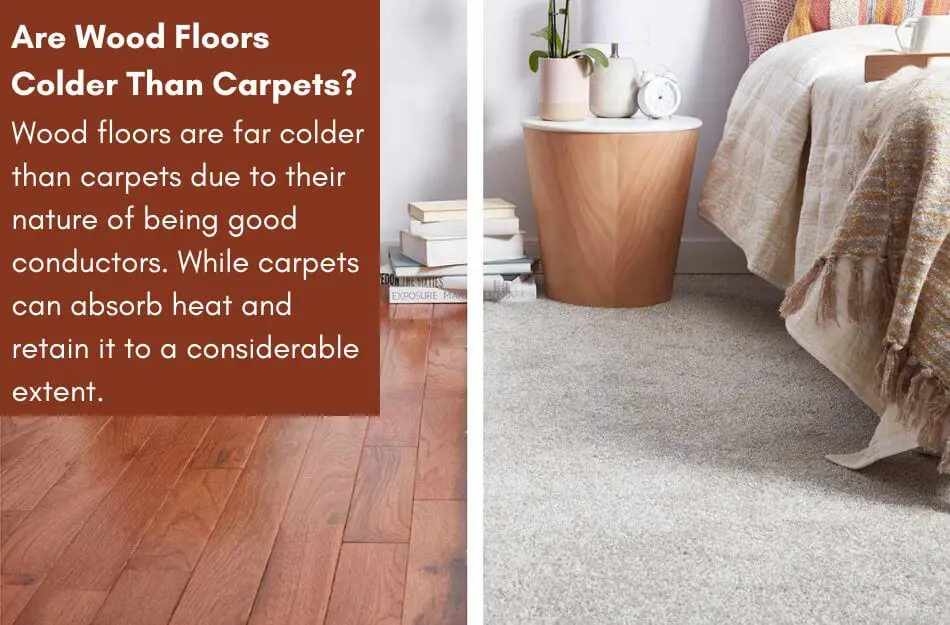
As a result, they drop the temperature of the room and imminently the house gets colder. Besides, carpets are also very efficient at trapping heat and hot air which makes them a perfect way to keep the floors insulated.
They also prevent loss of heat through ventilation or other methods which might make the area colder.
On the other hand, wooden floors absorb heat from the feet, environment, and walls, and disperse it to make the surroundings cooler.
They can also absorb heat from the surface underneath and make it colder by the same method.
How Do You Keep A Room Warm With Hardwood Floors?
There are many ways of keeping a room warm with hardwood floors such as getting an underlayment, installing carpets and area rugs, refinishing the surface, and installing space heaters in the room.
All of these factors can be done or you can choose any one of them for insulation purposes. All methods are effective and will surely help retain the heat to make the rooms warm even with hardwood floors.
An underlayment allows for the blockage to prevent heat loss and acts as a barrier under the surface of the hardwood floors.
This keeps the floors from dispersing heat to the surface below; hence, the heat is dispersed to the upper surface which makes the room warmer.
Carpets are also an excellent way of trapping heat on the surface. They can even insulate hardwood floors over a longer time period and can make them warm.
As a result, the overall temperature of the walls and the rooms begins to rise causing the room to become warmer.
Area rugs also work in a similar way as carpets but they do not cover the entire floor. They are suitable to keep a certain area warm and prevent it from getting cold.
For instance, if you have a TV in your bedroom, you can place the area rug in front of the sofa so you can keep your feet on the floor while watching your favorite show.
Using heaters is also an excellent way of making a room warm with hardwood floors as the constant emission of heat from them will gradually make the floors warm.
Besides, the walls and air in the room will also get warmer, resulting in an overall temperature increase.
However, you will have to ensure that the floor is either sealed or has an underlayment, and the doors/windows are closed so that the warmth is not lost through ventilation or conduction in the room.
Once you follow these methods, the temperature of your room is sure to rise to make the room much warmer despite the hardwood floors.
Does Flooring Affect Temperature?
The type of flooring can greatly affect the temperature in the house. For instance, tiles, marble, and wood floorings are usually colder while carpets, rugs, and few others are considered to be warmer.
At the end of the day, everything breaks down to conductors and insulators. Good conductors are cooler and will keep the overall temperature down while good insulators are warmer and will keep the overall temperature higher.
If you live in a colder climate, you must revert to floorings which have good insulating properties. If you are in a colder climate but still want to get hardwood floors installed, you should follow the steps mentioned above to cater to the cold floor problem.
However, living in a hotter climate can mark your hardwood floors as the best option without any doubt. Hotter climates call for flooring types with good conducting qualities so that they do not retain heat and allow it to be dispersed to keep the room cool.
Final Thoughts
Hardwood floors do certainly make your house colder but it is up to you whether you let it be a deterrent to the beauty of your house or you work your way around it to enhance the appearance and the ambience of your house.
No type of flooring is perfect and will certainly have some drawbacks. The same is the case with wood as its natural composition doesn’t allow it to retain the heat very well.
However, you must not let this be a reason for you to dislike hardwood floors as this problem can be solved by a few measures.
Even if you simply seal the surface, you will see great results as the floors will be able to retain heat well because the escape route from the wooden pores will be closed.
Furthermore, there are many other ways to cater to this problem which are mentioned above so make sure you have a good look at them.
If you live in a hot climate, there can’t be a better way to keep the house temperatures down to bearable with the help of hardwood floors.
However, being in a colder environment might initiate some problems with hardwood floors but the remedies mentioned above will surely come to help.
Therefore, if you also want to get hardwood floors installed but the only thing keeping you from doing it is the fact that hardwood floors are cold, you must not keep yourself in the dark any longer.
Make sure you follow the methods we’ve elaborated on earlier and get hardwood floors installed as soon as possible!

As a co-creator of FlooringFlow.com, Emma Sophia comes on board to answer all your questions related to any flooring problems. Together with John Henry, she’s gained extensive experience in fixing many flooring problems in their own house as well as in friends and family’s. Now, she wants to share her knowledge that she gained during floor remodeling, restoring, and DIY projects.

